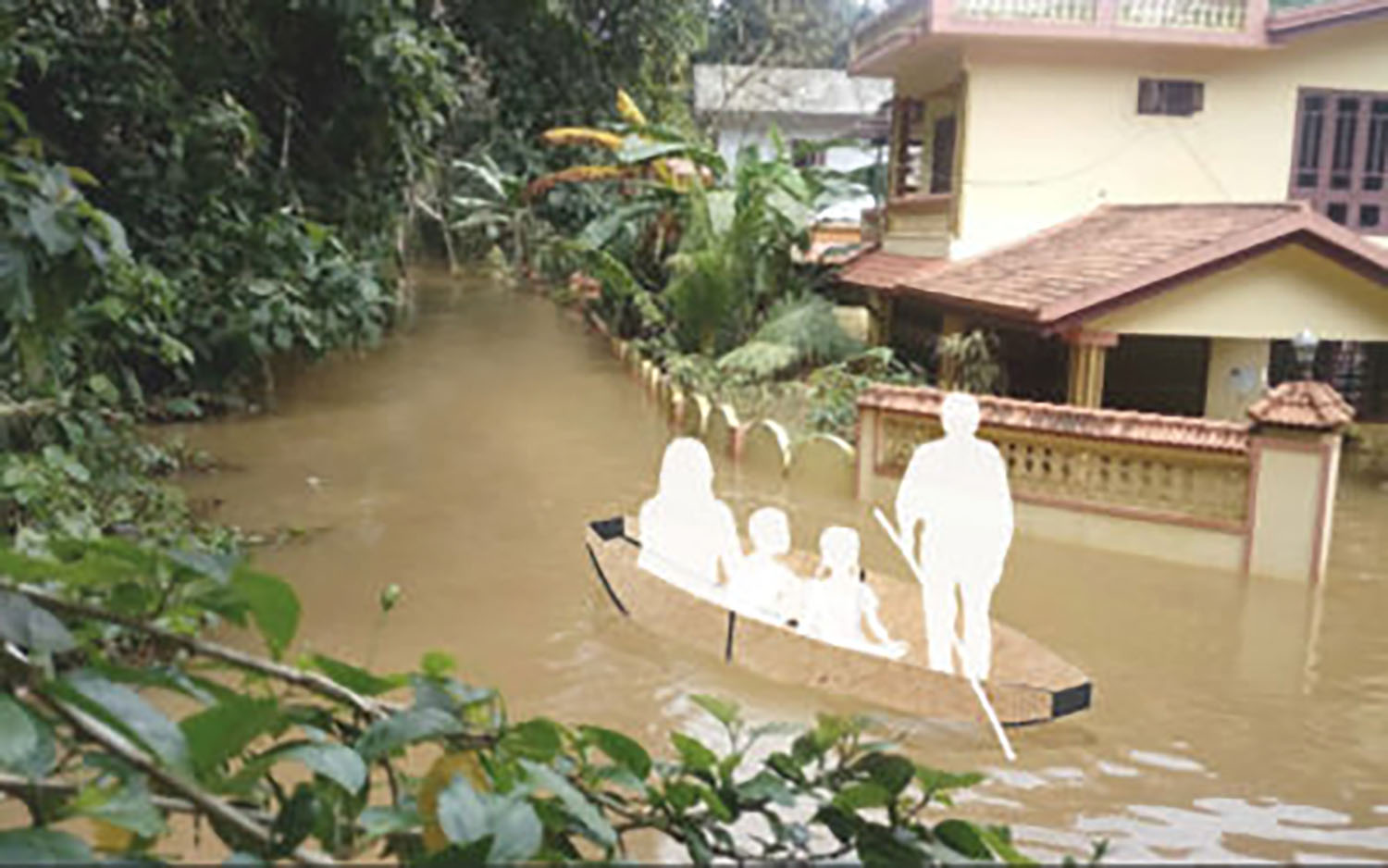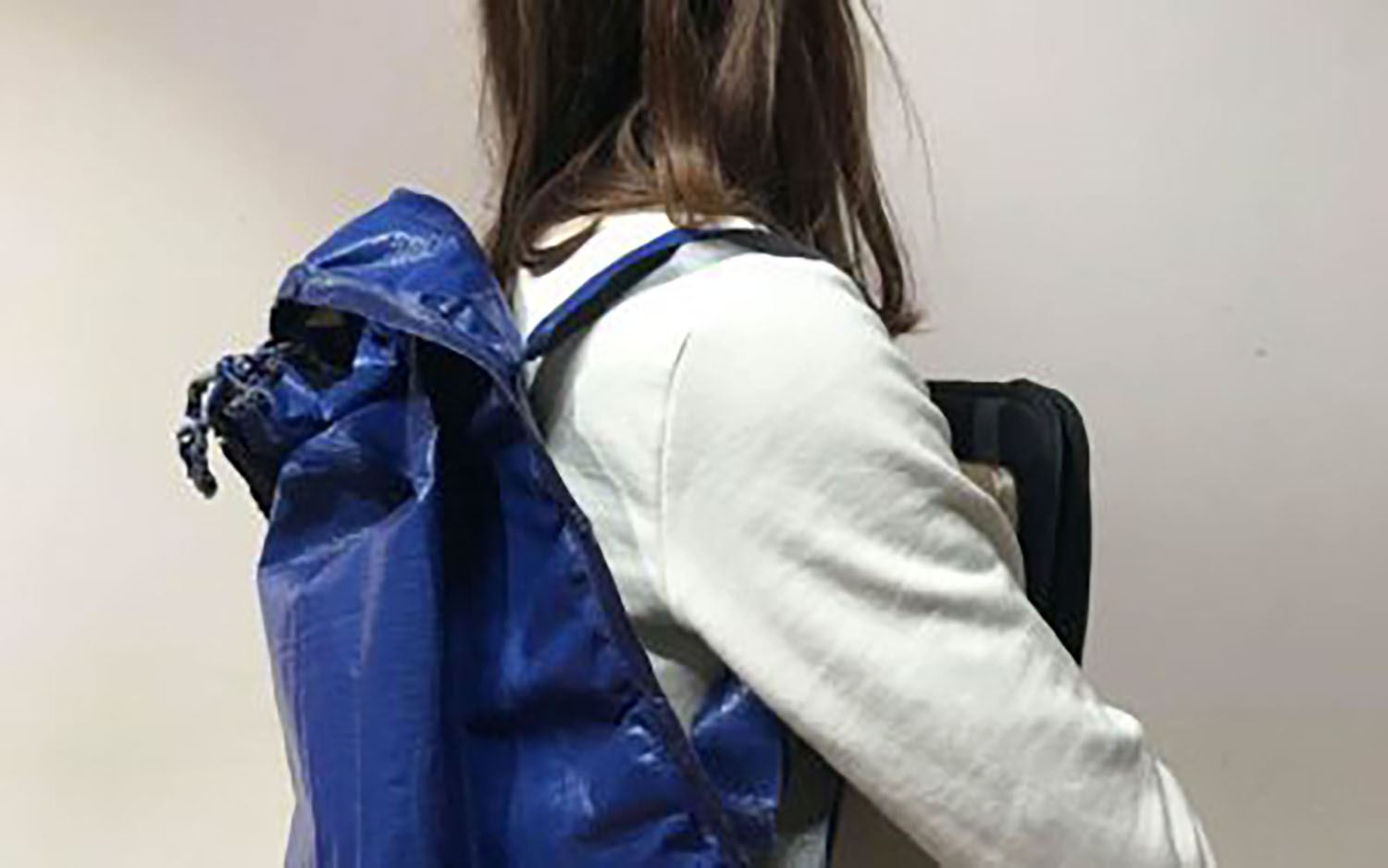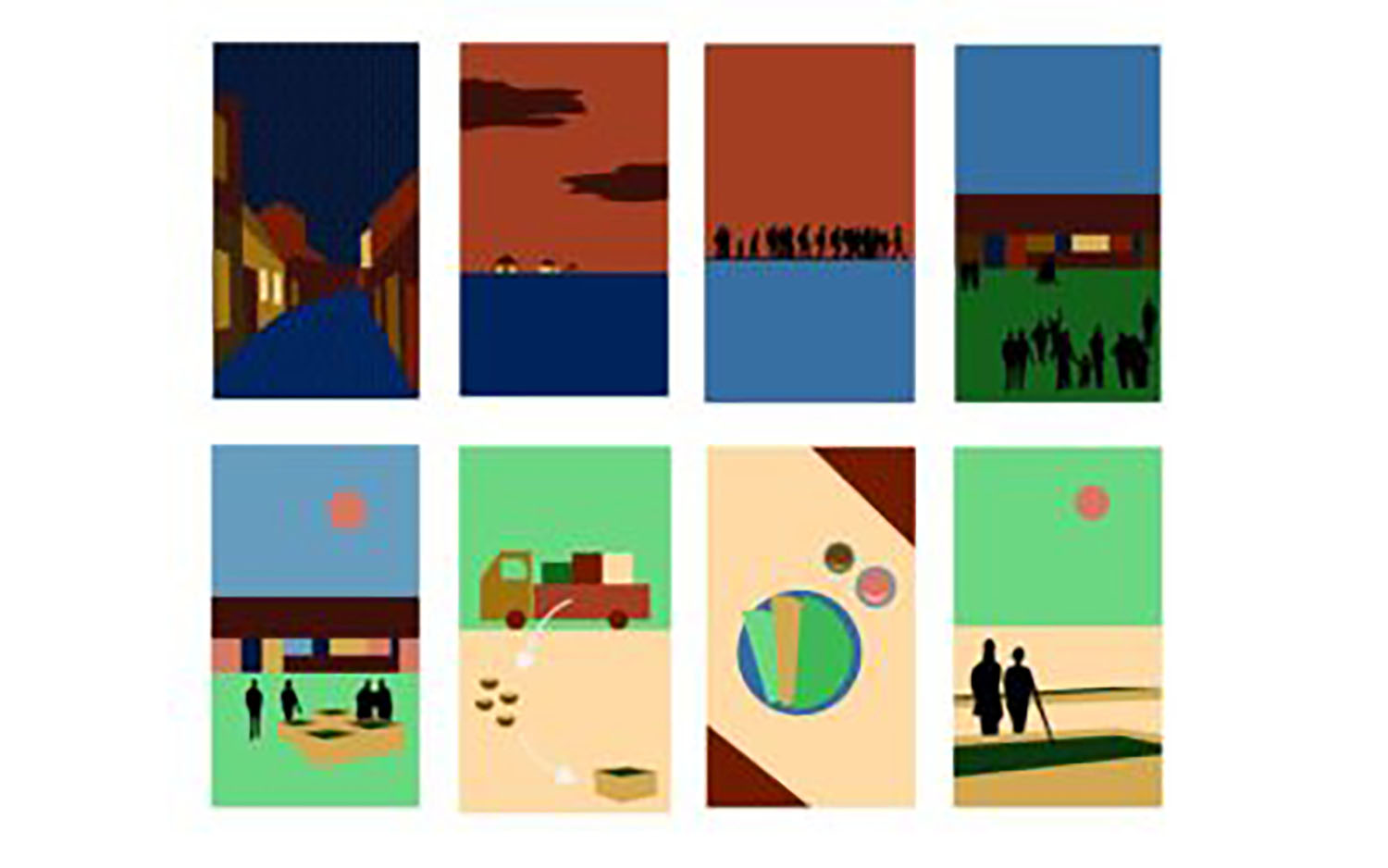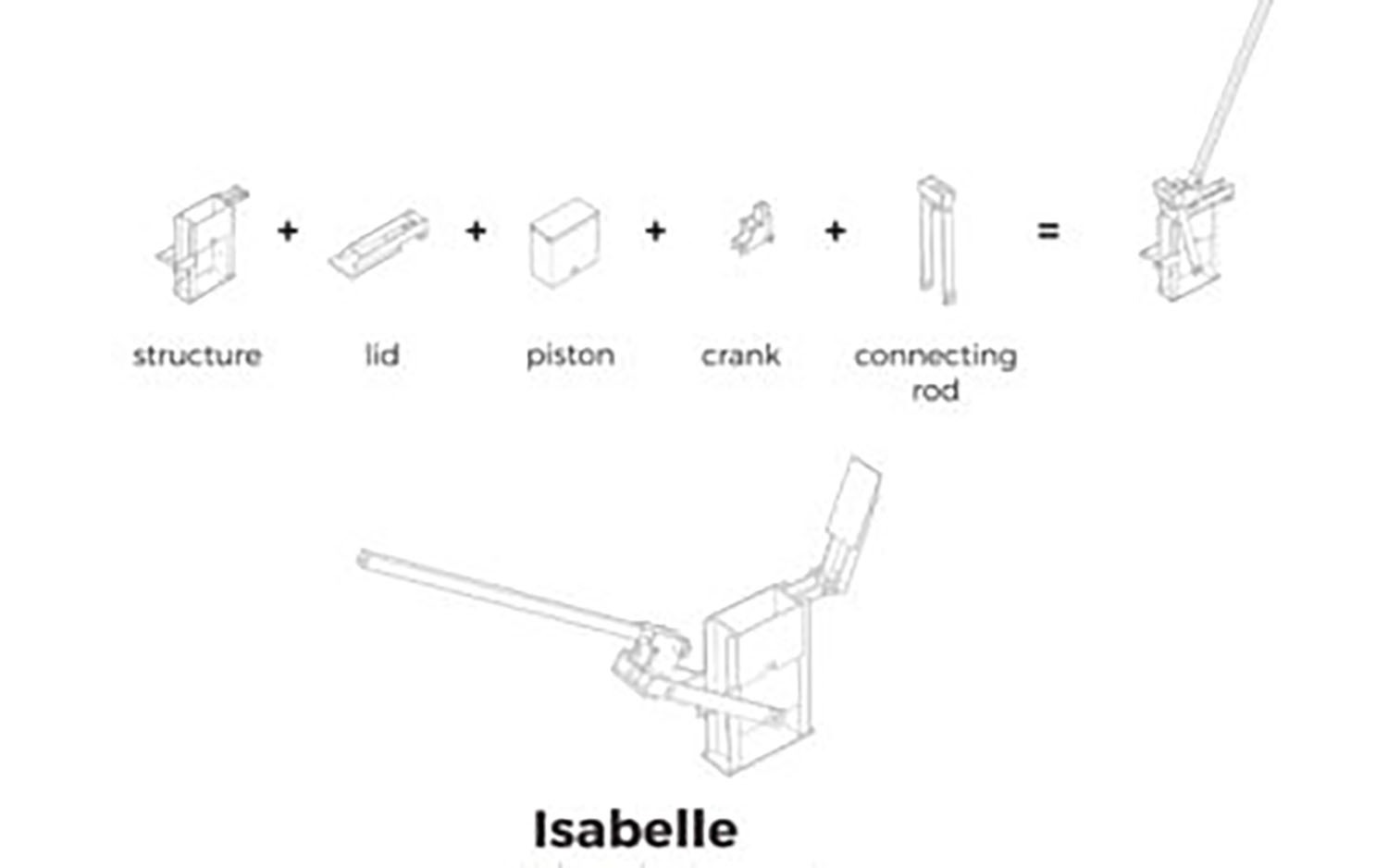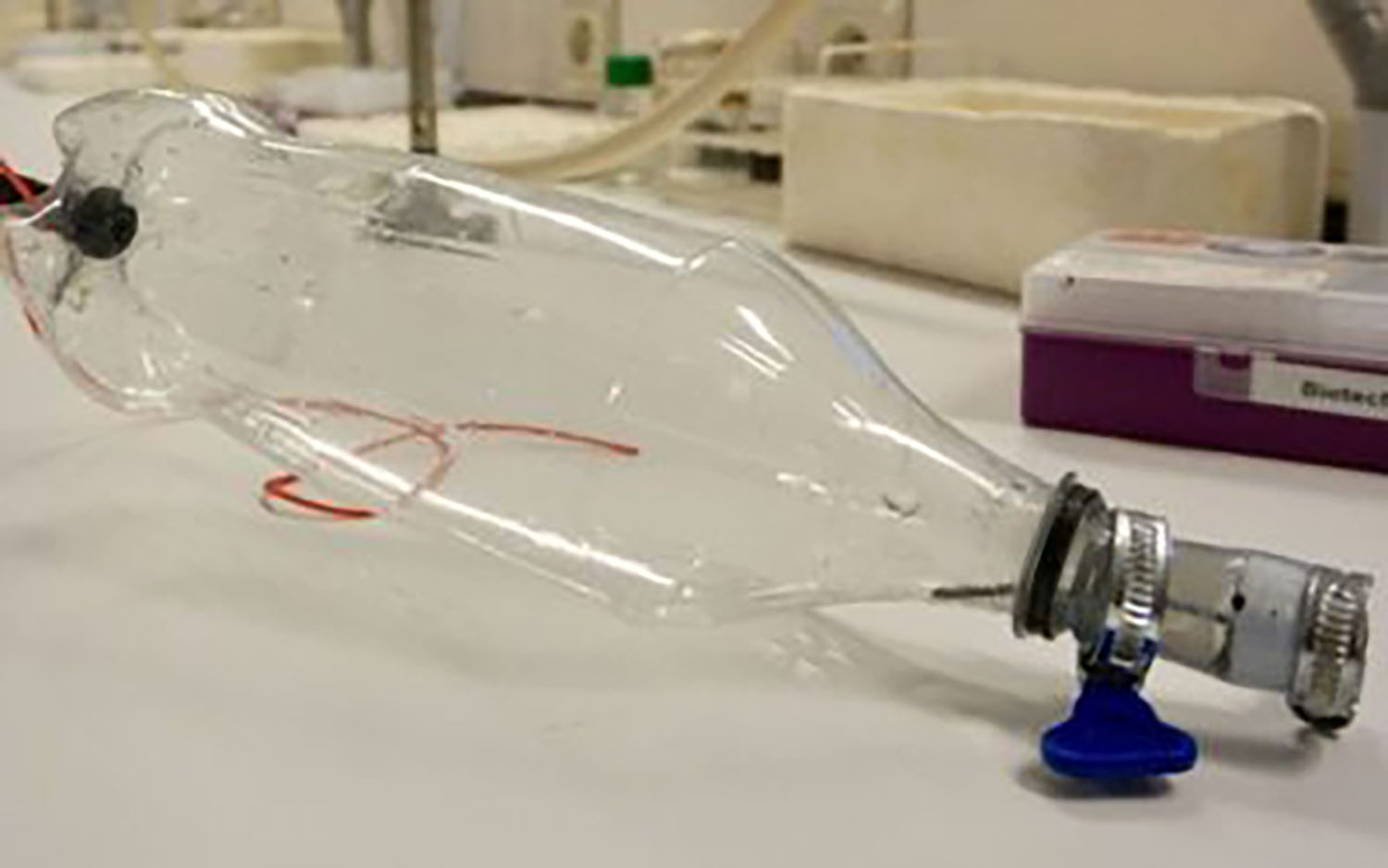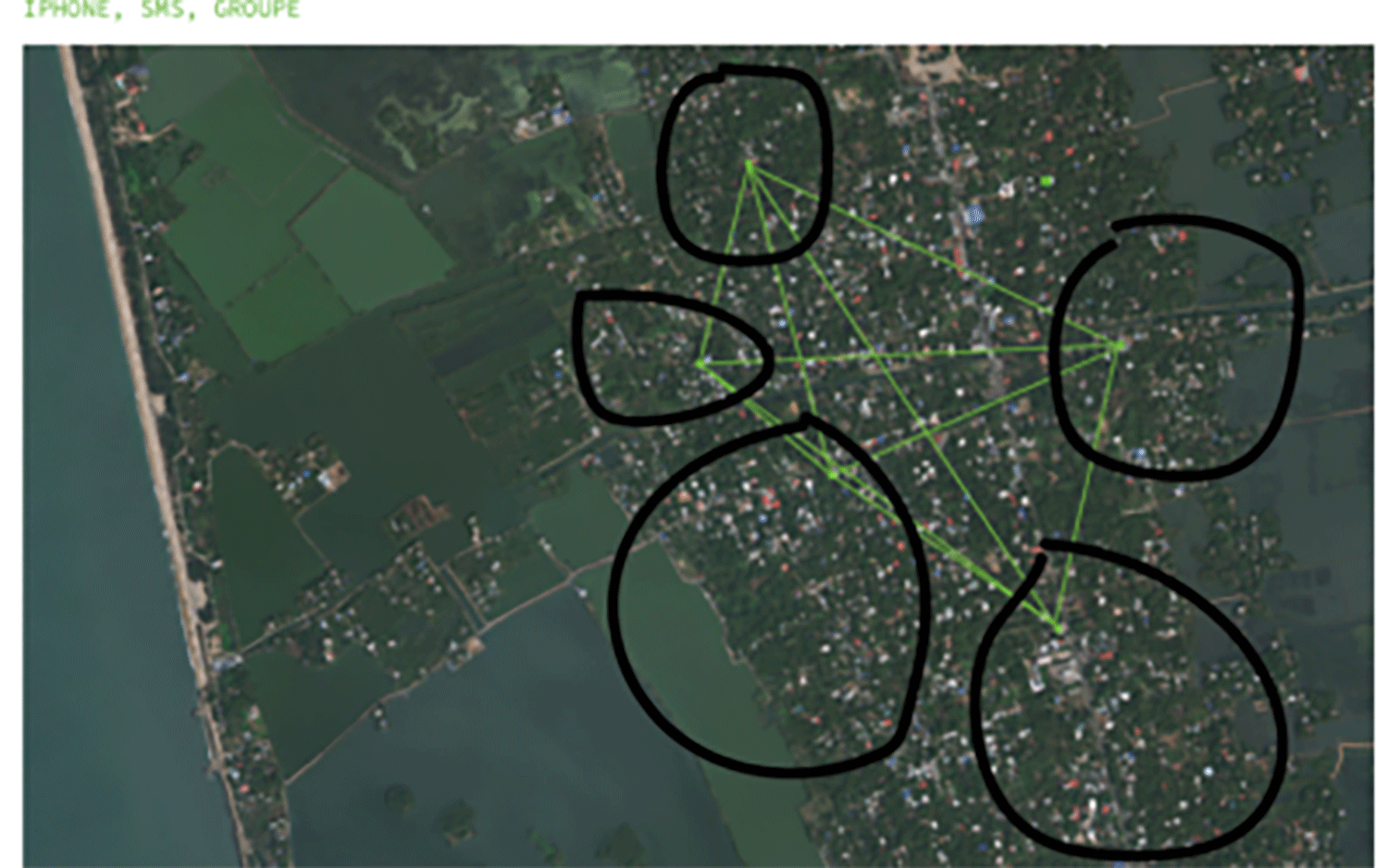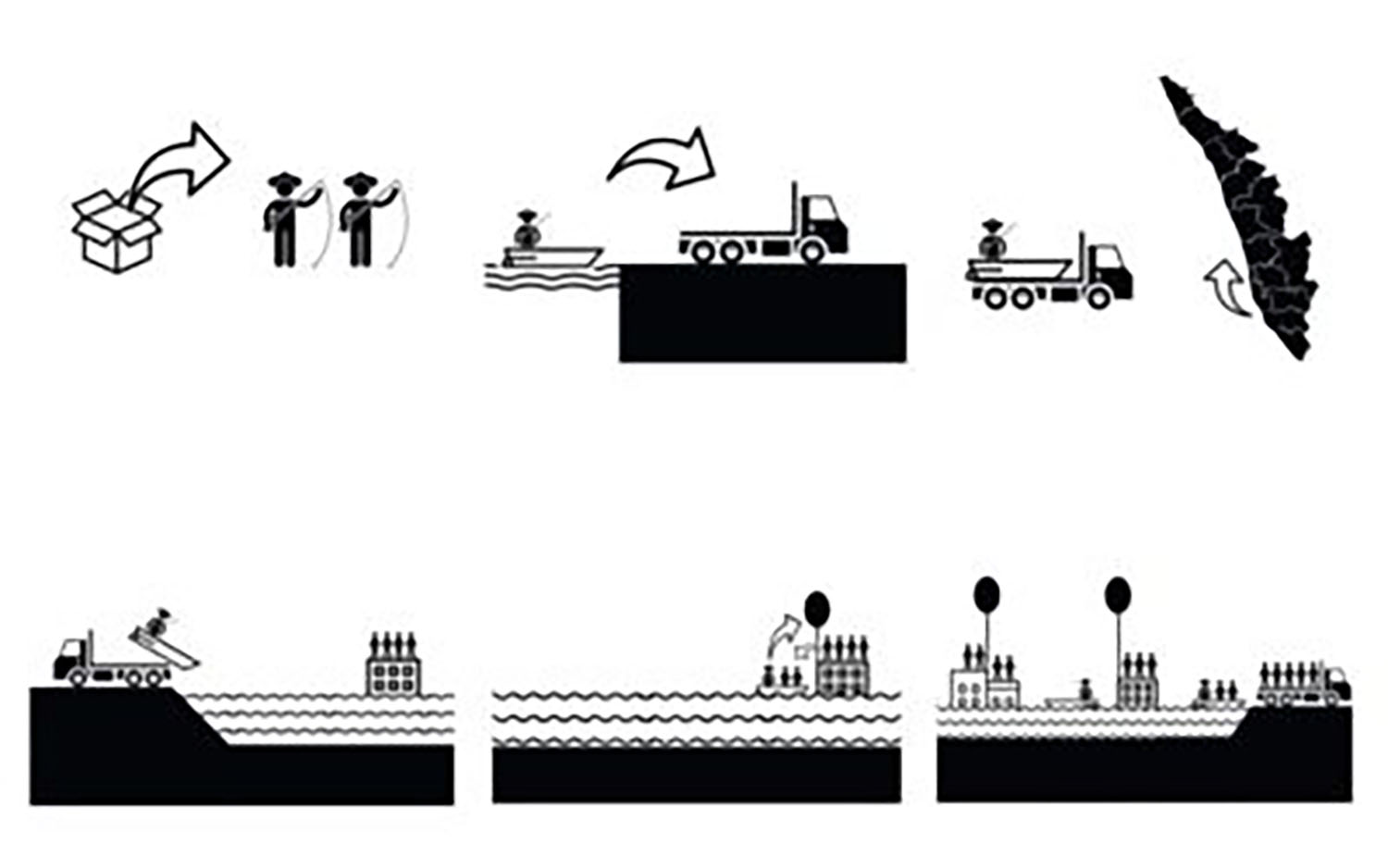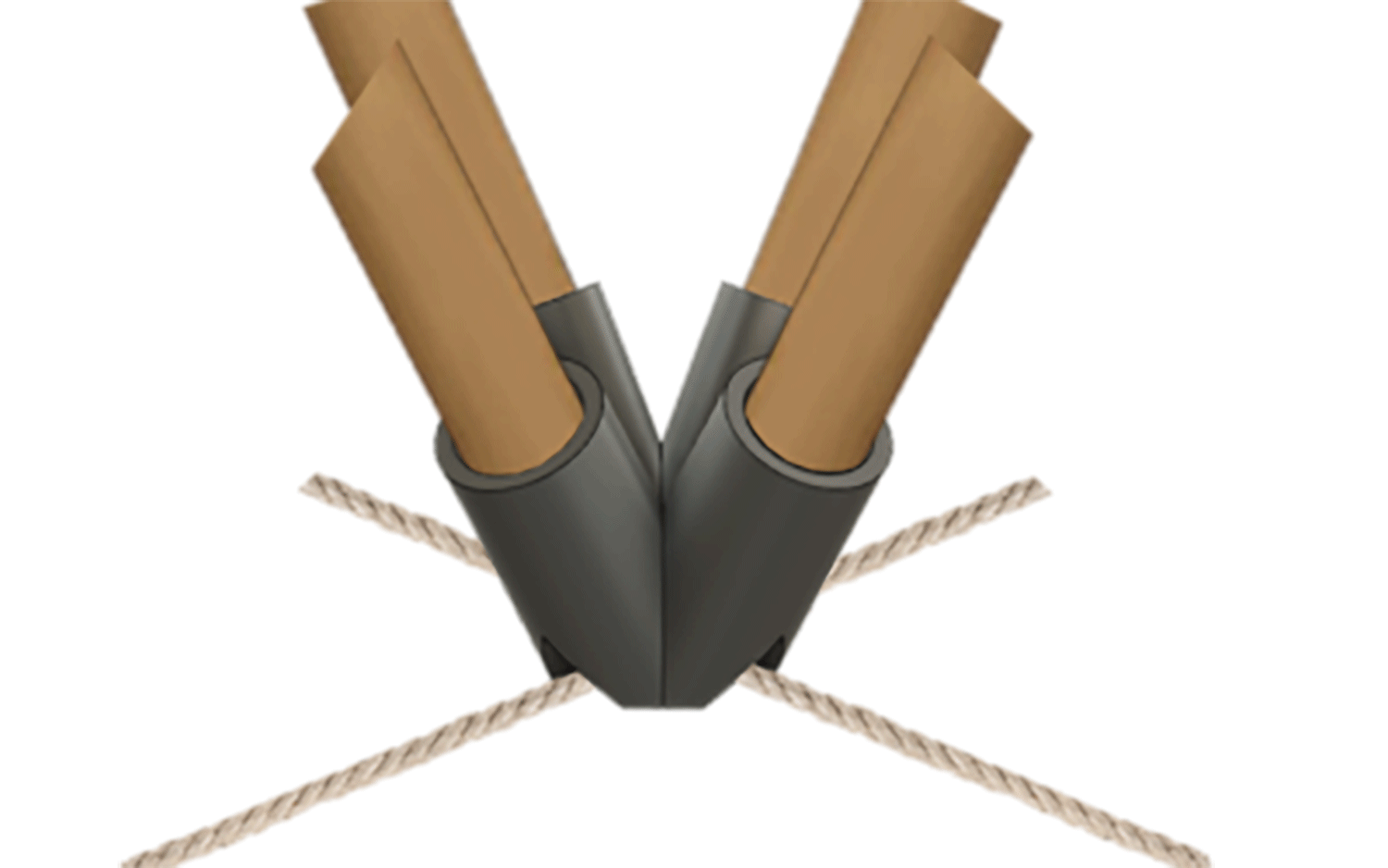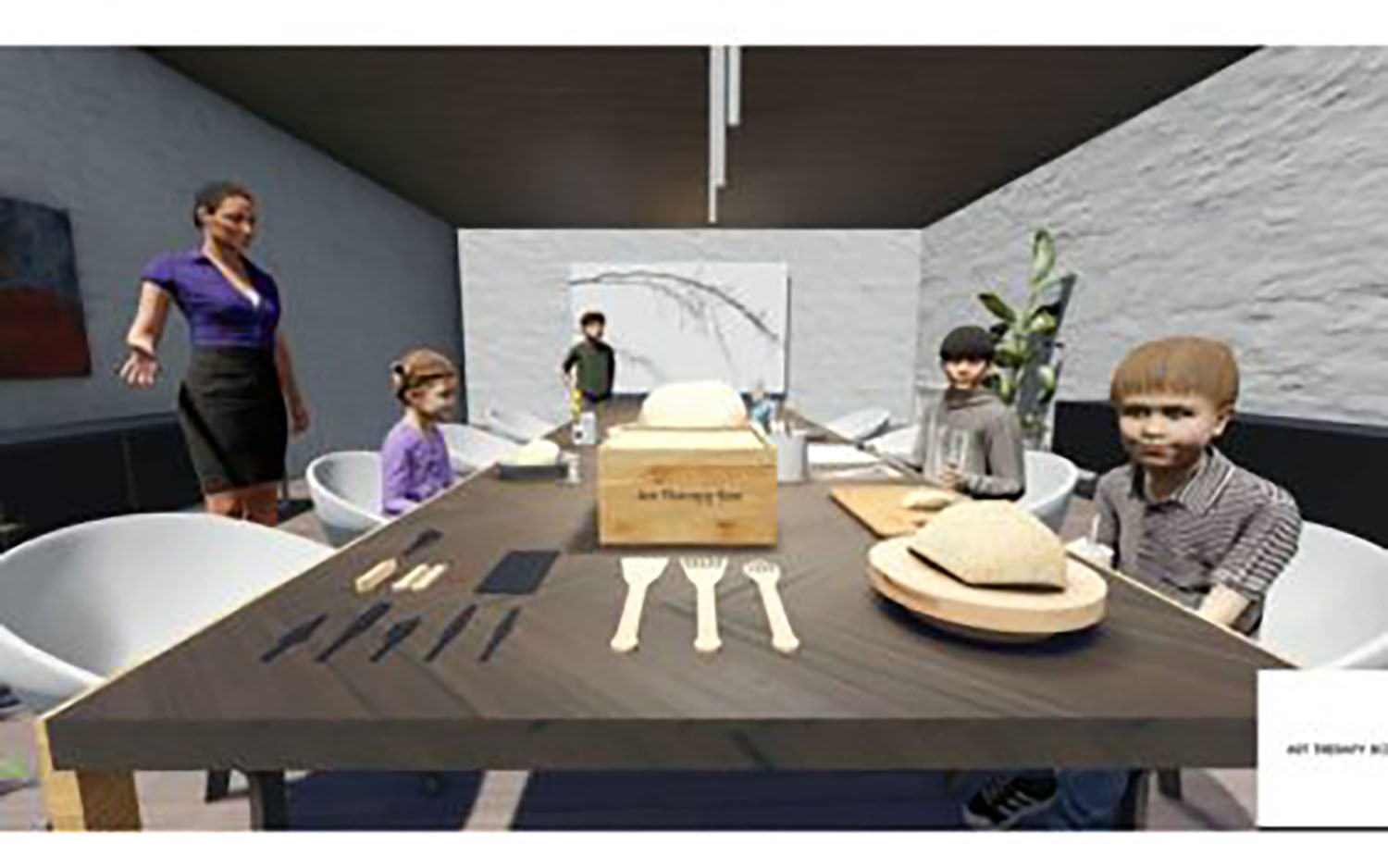Team : Elisabeth, Clémence and Grégory Project repository : Foldable Boat A foldable boat, low-tech, opensource and easily constructable with one single sheet of wood. Project Summary This project takes place in the context of the floods of August 2018 which...
DFS Q1 2018/2019 – Projects
44 students of the Université Libre de Bruxelles ULB (Belgium) and from different faculties such as architecture, sciences, polytechnics and law, worked in the Fablab ULB on the humanitarian emergency due to the Kerala floods that happened in India in August 2018.
The aim of the Digital Fabrication Studio DFS Q1 class was to explore how digital fabrication, Fablabs and the worldwide network of Fablabs can be of use in humanitarian aid after big catastrophes such as the Kerala floods.
In collaboration with people from the Fablabs network in Kerala but also a series of national and international experts, the students developed open-source projects that they prototyped and documented.
This work was made under the supervision of Prof. Victor Levy et Prof. Denis Terwagne during the DFS Q1 class at the Université Libre de Bruxelles (ULB)
Here is the result of their work.
2018-19 DFS-Q1 Class process
authors: Victor Levy and Denis Terwagne
An unexpected message from Kerala, India
It all started with a Telegram message from Sibu on a day of summer 2018. Sibu is a member of the fablab community in Kerala, India. We are from Fablab ULB in Brussels, Belgium.
The Kerala region was under heavy rain, the monsoon was unusually intense. The water level was rising fast and the Kerala state authorities were forced to open 35 of its 54 dams to avoid further damage. This was a catastrophe, bridges collapsed, hundreds of people died, most of Kerala was under water, one million refugees.
Sibu with several other Indian guys were relating the events on Telegram. Houses were destroyed, snakes were swimming and biting people, mud was everywhere in electronics, furnitures, mattresses, …
People in Kerala needed to organize themselves. They needed to find ways to communicate, ways to save people, ways to feed refugees, ways to organize, ways to remove the debris that were everywhere, ways to create temporary shelters, ways to clean stuffs soaked in water and mud,…
People from the worldwide Fablab network responded and some help was organized. Temporary shelters were sent, water purifiers were on their way although they needed some supply from outside the country that did not arrived,…
With Victor, we wanted to contribute and give some help. We were wondering :
What could achieve 40 students in a fablab (Fablab ULB, Belgium) from different disciplines and countries, working together with the worldwide Fablabs network to develop solutions to help people from Kerala ?
Getting to know the students
We gathered the students from our class Digital Fabrication Studio Q1 that takes place during the first semester of the academic year and we exposed the situation. People were excited to be part of this adventure. Expectations were quite high from the students.
First, we wanted to know the students we have around the table. They are from different disciplines architecture mostly but also physics, engineers and fine arts students. We have students from all over the world : Belgium, France, Spain, Brazil, Poland, Quebec in Canada,… We wanted to know what are their passions, what they are made of,… some already have experience with humanitarian aid, some are high level sports people, … Everybody as something special that might be useful for the class at some point to help people of Kerala,…
Playing to learn digital tools and the power of collaboration
The journey is going to be rough, full of uncertainties. So the next step was for them to learn the power of collaboration, how they can self-teach each other and how to use digital fabrication tools. To do that, we proposed to the students to build a collaborative game in group using 2D and 3D design tools and the laser cutter. This assignment was really something and it went really well. Playing, sharing and learning.
Brainstorming and sharing food
The first step was to get to know the situation in Kerala about the floods, about the culture, about the fablabs,…
Along the team building, we asked the students to gather knowledge from the Kerala situation. Each students came with an image of the floods that he commented. For each image, the group of students had to propose 3 solutions that came directly to their head. This way we were training the ability of the students to rapidly imagine a solution facing a problem so they would become solution-oriented. We were learning as we were moving. The question was raised : how do we get reliable information ? What are the sources ? How to make the research ? Students explained how they did it. Some went on Instagram and collected testimonies, some other went directly to the Indian newspapers, some others used YouTube or social media such as WhatsApp, Telegram or Facebook.
Sharing food is one of the most important ingredient to create a group spirit in the class.
Defining the class assignment with the students
But where are we going ? The students do not really like uncertainties, when the question or the path is not clearly written at the beginning. We did our best to be transparent with them. We played with no hidden cards… We think that it is important for the student to define their goals themselves and to be transparent on how we think as professionals/teachers in these kind of situations.
How did we proceed to define the class assigment ? We started a debate by simply stating the reality : people in Kerala are in need, we are in a Fablab connected to the worldwide network of Fablabs, we are 44 students with our knowledge, know-how, passions, we are in a university with a lot of experts and knowledge, we know experts national and international experts that can help us. What do we do ? This was the beginning of the debate we had with the students.
Reaching out to make a connection with Kerala
To be able to know what we can do, we have to know more about the situation in Kerala. We needed to be connected to local people in India.
The students decided to start trying to reach people in Kerala using several social media, emails, phone calls. On our side, we had sent a request on Telegram (Fab for Kerala) that was active until that point but no answer yet. Students tried to reach embassies, NGOs, … but this is not easy. Some typical responses were “why do you want to help ? We don’t need help”. We started to be really frustrated and started to investigate why India was even refusing help from other governments. Indonesia was behaving the same with their tsunami. But why on earth, people in need do not want help ??? And then it strikes us. We had a conversation with Kyran a professor architecture which originated from India. She explained how it was there. Another students from the group which also had Indian origin started to share the Indian culture. We understood that the very reason we wanted to help them was to learn from them. We were fascinated by what was happening there and how people were responding to the catastrophe. So we turned our messages differently. We explained that we were students from Belgium that have to develop low tech and open source solutions in the context of Fablabs and the Fablab network to address humanitarian emergency such as the one in Kerala. We needed counseling. In return, if our projects would be helpful for Kerala we would be more than pleased. So we were not going to offer direct help but we would help them to help themselves.
By doing so with a little help of Romain Di Vozzo in Paris, we managed to turn the network attention on our project.
Suddenly, we have an answer from Kerala with people ready to help us
And suddenly, while being a little desperate, several Indians were answering to our call on Telegram and rapidly we decided to organize a video conference.
Students were excited and at the same time scared to death at the idea of confronting their ideas to the real world and real people.
Meeting Michäël Gäthögö, a Kenya humanitarian maker
Michäël Gäthögö is a humanitarian maker that was in Belgium to train as a NGO MSF camp (Médecins Sans Frontières or in english Doctors Without Borders). We learned that, in Brussels, there was a training refugee camp and people from all over the world were coming to be trained to respond in time of huge catastrophes all around the world.
Michäël knows very well the field, the life in refugee camps. He came one evening to show us all that he was doing. We learned that, in these unconventional situations, we have to set aside our certitudes (they are usually wrong) and be open to start to observe and understand clearly the origin of a problem. This is really important so we can start to be creative and respond to the problem. Sometimes we don’t need highly technological intervention but a simple and clever response could help a lot and radically change the life of people.
Boosting the class project with collective intelligence
To prepare the video conference, we needed to define better what we wanted to do as a class. Each student had some idea of a project but they were all over the place.
So we asked Anissa to give us a little help. Anissa Ouertani is a consultant in collective intelligence. She likes to say that she is just there to put oil in the social human machine. We let her the class for one and a half day. We would accept to play the game. She did a tremendous job ! First we reflected on how to behave as individual in a group, to respect everybody, we learned a code of conduct,… Then we experienced a way to make group decisions by applying a method of “gestion par consentement”. We, Victor and I as teachers, proposed a class assignment and students would have the ability to ask for clarification, make remarks, then we would reformulate the statement, along with another round of clarification and now comes the round of objections. They were some objections that would be rapidly be relieved after some explanations or little tweaks in the wordings of the assignment. As nobody had an objection, the statement has been accepted and we celebrated this very important step ! This process was a real relief for the students as for the first time we were going to build on a solid basis made by the group on which everybody agrees.
The next day with Anissa was about defining the students projects. An intense program where students learned the power of collaboration, we played different games for ice-breaker, collaboration, to reflect again on how we behave as individuals and as a group,… students brainstormed different projects, they grouped by thematics and made four larger groups that would organize and meet regularly to exchange state of the art, questions, problems,… we learned a lot of different sociocratic tools that we would use for the rest of the class. After that day, students were exhausted, not sure about where they where but at the end they were happy because they had made decisions and there were less uncertainty.
First video conference with Kerala
Then came the day of the video conference with Kerala. We gathered all the student in Denis’ Science lab (where the internet connection is more stable…). 44 students in the lab that was a lot. We decided to make a fish bowl where there is an inner circle with group representatives and the computer holding the video conference. The rest of the student were around the inner circle (in an outer circle). Stress was really high. We used another tool that Anissa taught us which is by passing a “baton de parole” (a speaking stick) everybody had the opportunity to express himself. How he feels and what are his expectations. Denis felt that the class was really stressed and needed to be calm before the video conference. So he improvised a guided meditation which reveals to be life-saving. Everybody was more calm and attention was high.
Then came the moment of the video conference. We have 7 people from Kerala that are connected by one way or another to a Fablab in Kerala. They were really kind and helpful. They explained the situation they lived in details. Three students were writing all they were hearing. They were lot’s of information exchanged. Then the different group representatives asked questions related to their projects. This part was more than helpful. First most of the students understood that they were doing something real further than the simple abstract assignment. Also, they understood that their idea they had in mind might have a potential impact and be useful to other people. After the talk, students were shaken by all the information they received but at the same time they were empowered with confidence that they are doing something meaningful.
In the afternoon, a group of students would start a collaborative document to report the meeting. This document would be used as a common basis on which we can build the rest of the projects. Another group of students decided to reorganize the group thematics in different categories related to the timing of the catastrophe: prevention (before a potential flood catastrophe), during the catastrophe (chaos), during the refugee camps (a few weeks or months after the catastrophe) and the reconstruction phase (few years). Energy in the class is at its highest. Students starts to see the relevance of their projects and wanted to celebrate. We went for a drink in a bar nearby.
The different projects were still a bit abstract and not really well rooted with reality. We thus pushed them to rapid prototype part of their project to see the weakness and the strength of each project.
One week away in the countryside
During this class, there is one really important moment, usually a time for transformation for the students and the class and a milestone for the projects development. It is the one week stay in the countryside were students are away of all their usual busy life and were they could concentrate only on their project.
This year we chose Haugimont (Faulx-Les-Tombes) a remote place in the Belgian countryside. Furthermore we would be really close to the Fablab of Andenne, a small town in the south of Belgium.
Haugimont is surrounded by hundreds of hectares of forest which are managed by Charles Debois from the University of Namur. Charles would be our guide in this remote place.
We invested a lot of energy in making the group to bond while immersing each student in the context of their project. We would question each parts of their project. Now, that the projects are getting more defined. Students start to confront them to external « experts », Michael Gäthögö, a Kenyan maker that works in refugee camps was of an invaluable help. People from the Indian FabLab from Kerala were quite responsive too on the Telegram.
The forest is dying, let’s plant trees
While we were at Haugimont, we learned that due to climate change and the very hot summer we had, our forest of spruces were sick and dead trees had to be cut. Charles Debois and the University of Namur proposed a very creative idea which was to plant acorns (from the oak) with the community to allow the forest to regenerate naturally.
We participated to the launch of the operation with the press and the students.
Charles had invited all the Belgian press, newspapers, television and we participated to the initiation phase of the operation. The new forest was planted so fast, we planted half an hectare of forest in less than half an hour. We even planted parcels of the forest that had not been already cut.
This was an opportunity for the student to learn that :
When a problem comes, it is an opportunity to create a solution that not just fixes the problem but improves the overall situation.
The operation continues and is related on this website (in french) : https://dtwg.gitlab.io/reactionenchene/
Prototypes, prototypes and prototypes
We spend the next two days at the Yourlab, the fablab of Andenne where students would prototype and question their project. Nicolas Arnould the fabmanager from YourLab was really helpful. This was really intense.
In the evening, we would share food that the students have made. We even ate indian food that Lucie prepared for us. That was so good.
The last day, students shared their work they have done during the week with pecha-kucha presentations.
This whole week was a pretty important time where we learned to work as a group with its ups and downs. Every time there is a problem, we would discuss on how to solve it. It is a habit to take, not just complain about problems but acting to solve them. The group was rock solid at the end of the week.
After that intense week, we usually have a small down in the group energy. This is normal. Rapidly, most of the groups where defining their final projects and made a short summary of it.
The different projects summary were send to Kerala and a second video conference was organized.
Reaching out for help
The projects are more and more relevant but students need support, they need experts that could give them advice to realize their projects. We have plenty of competent people all around us in our university, outside our university, national, international, in the fablab network, … We pushed students to reach out for help which worked pretty well. They have contacted about 60+ national and international experts (listed below) that gave tremendous help. We really want to thank everybody that helped us in this adventure !! The quality of the projects improved a lot thanks to outside help.
After the second skype with Kerala, some groups were already very advanced and others were completely lost. So here comes the work of surgical operations were we would help students to transform their problems into opportunity to improve their projects. Every group was different with efficient and less efficient processes. But at the end, it worked fine for nearly all of them.
Médecins Sans Frontières – Doctors Without Borders mass catastrophe exercice
Thanks to Michael, we were contacted to participate at a real scale simulation of a mass catastrophe at the MSF (Doctors Without Borders) simulation camp in Brussels. That was an opportunity for us and the students to see and feel what it is to be like in the chaos of a mass catastrophe. It also allows us to meet professional field agents that have a knowledge of the needs on the field.
First pre-jury
Just before Christmas, we organized a day of presentations for the projects. Students prepared a Pecha-Kucha, 20 slides and 20 seconds per slide. This presentation format was invented by designers to share rapidly and dynamically their work. Students have to prepare. They don’t always like the strong constrained but after training several time, it worked pretty well. They would also present all the prototypes they have made. The general conclusion was that for most of the groups, their project was really well defined thanks to the experts they have met and their research on the situation in Kerala. However, prototypes could have been more developed. Rapid prototyping is a skill you have to learn and practice. The technological skills is sometime a barrier to allow the students to express their thoughts through the realization of prototypes in the fablab. These are important skills that Fablabs can help to train.
Final jury
One week before the final project presentation in front of a jury, students pushed their projects very hard. It is a strange habit in the architecture culture, they would wait until being really close to the deadline, for a last hard push that sometimes give ways to very creative solution. When under stress, you are forced to make decision and if stuck, you have to find a solution that can sometimes be surprisingly creative.
With Victor, we opened the fablab and students would come for the final push. We felt our help was not anymore required. We felt obsolete. That is the best (and weirdest) feeling a teacher can feel announcing that students have taken the lead on their project, they know where they were going, energy was on their side, they were autonomous.
On the day of the final presentation. We have invited Kiran, a Belgian architects from ULB that have Indian origin, Romain Di Vozzo leading the Fablab Digiscope at the University Paris-Saclay, Antonio, a MSF field agent that work in refugee camps and build hospital all over the world, Nicolas De Coster, a meteorologist that spend all his spare time in our fablab, Xavier Willot a fabmanager, designer and photographer, Axel Cornu a skilled electronician, David Jushpe a skilled autodidact/DIY and Julien Cabay, a researcher and ULB professor of Intellectual Property.
Each group had the opportunity to report their work. We would appreciate (i) how relevant is the problem they have identified and how they propose to act to solve it and (ii) the prototype they have made that demonstrates the feasibility of their project in fablabs.
Here are a few remarkable projects among others, where we can appreciate the project and the process the students have followed:
Adrien Centonze, the new fabmanager of Fablab ULB, that was hired at the end of the class, helped us to build this website with the students. This website was built in less than a week. But it was important that the projects of the students could be documented and spread in the fablab network and all over the world. Thank you Adrien for your hard work.
Here is the final group photo. thanks to everybody !!
Students list
Raquel ALONSO PALOMO
Thomas ANGHELOVICI
Gonzalo AUGER PORTILLO
Montse BALLE
Clémence BAUDSON
Nicolaos BIBISSIDIS
Eloïse BISSELL
Henri BISTUER
Nathan CAILLÉ
Lucile CAU-JOINDANNES
Claire CHAVIGNY
Katarzyna CHLODEK
Laurence COTIN
Anouk DAGUIN–DELIN
Cindy DE SOUSA OLIVEIRA
Carla DEBARRE
Marie DELINTE
Maëva EFOLOKO BOSONGU
Soujoud EL MUHUR
Claudio GAZANEO BARBOZA
Thomas GOFFINET
Louise GORIOUX
Marie HAUDRECHY
Vy HOANG
Marie-Melissa KENNES
Ibrahim KHALED
Alexandre KRYSIAK
Eugénie LE MERLE-VIGUIÉ
Noel LIMA ELIAS DE SOUZA
Alba LLEVADOT MASSANÉS
Carmine MONTUORO
Lucie PARIYAR
Alessandro PERLAUX
Marta PORCU
Adrien ROEMERS
Caroline ROUX
Irène SIX
Elisabeth SKWARA
Karine TAILLON
Ombeline THIERRY
Jean TWYFFELS
Grégory VANDEN BROECK
Marie VANDER MEULEN
Louis WILLAUME
Aurore WILLEMS
Special thanks
This was possible thanks to all these people (60+) that were contacted by members of the class and helped and supported the projects in one way or another.
- Romain Di Vozzo, Chief project of Fablab at Paris-Saclay University (Paris, France)
All members of the Fab for Kerala chat on Telegram
Pauline Kennes, MSF (Doctors Without Borders) agent, Belgium
Antonio Limanni Macaione, MSF (Doctors Without Borders) agent, Belgium
Charles Debois, Forest engineer, University of Namur, Belgium
Nicolas Arnould, fabmanager @Yourlab, Andenne, Belgium
Anissa Ouertani, consultant in collective intelligence, Belgium
Julien Cabay, ULB researcher and professor, Brussels, Belgium
Adrien Centonze, fabmanager @Fablab ULB, Brussels, Belgium
Michäël Gäthögö, social maker, Kenya
IOM – UN International Organization for Migration, Geneva, Switzerland
Fab for Kerala (Telegram)
Fablab Kochi (Kerala, India)
Fablab Trivandrum (Kerala, India)
Vishnu Easwaran (Kerala, India)
Rahul Rajan (Kerala, India)
Jogin Francis (Kerala, India)
Ganadev Prajapathy (Kerala, India)
Vinod Kumar, in charge of Fablab Trivandrum (Kerala, India)
Sibu Saman (Kerala, India)
Jim J Seelan, Mechanical Engineer (Kerala, India)
Yogesh Kulkarni, Executive director of Vigyan Ashram (India)
Le groupe Kanavu கனவு
Espace machine à coudre « Singer », Fernand Coq
People for animals
Álvaro Sánchez Calvente
Preethi Seevalsan
Humane Animal Society
Aways group
Nishant Aggarwal
Anu Jacob
Philippe
Pedro
Magasin Leconte et magasin de vélo
Michel Roux
Prithvi Vesla
Kerala Indian Red Cross
Indian Red Cross
Parvin Dersingh
Catherine Bachy
PermaFungi
Paris Laxmi
Anthony Fragale, former DFS student, Belgium
Daniel Del Pozo
Sam Calisch, Ph.D student at the CBA Center for Bits and Atoms, MIT, Cambridge, USA
Rehna
khalsa aid
Rajiv Menon
Charles De Cannière, ULB professor, Brussels, Belgium
Pierre Servais, ULB professor, Brussels, Belgium
Evelyne Menne
Vivaqua
Jean-Marie Dou
Siddhartha Amin
Xavier Pitarch
Sulekha
Annelies Crabbe
Gilles Planchon
Antenna Foundation
Teramer Montpellier
David Jushpe, autodidact DIY pro, Belgium
Elak Electronics
Origine Bleue
SPIRULINE / SPIRUVIE
Waterproof Bag
Team : Caroline Roux, Laurence Cotin & Vy Hoang Project repository : sac-etanche Final Project : NIRVIVAAD Team : Caroline Roux, Laurence Cotin & Vy Hoang A Low cost and Low Tech waterproof backpack Project Summary After doing some researchs and talking...
Spirulina Culture
Team : Marta Porcu - Carmine Montuoro - Nathan Caillé Project repository : spirulina-culture Final Project : Spirulina Culture Kit Team : Marta Porcu - Carmine Montuoro - Nathan Caillé Spirulina culture kit low-tech and opensource (air pump + Secchi disk +...
Electricity
Team : Jihad Guenaou, Adrien Roemers Project repository : Electric Generator Kit Final project : Electric Generator Kit Open-source lowtech electric generator kit with a mechanical system (if no bike, achievable in mdf panel) and with an electric circuit to...
Brick Press
Team : Montse Balle, Marie Vander Meulen, Irène Six Project repository : Brick Press < p dir="auto">A low-tech brick-press in open source, achievable in a Fablab ISABELLE BRICK-PRESS Our first prototype is based on the Isabelle brick press machine from...
Water Filter
Team : Marie-Melissa Kennes, Aurore Willems, Cindy De Sousa Oliveira, Nicolaos Bibissidis Project repository : water-filter Final project: Water Filter < p dir="auto">team: Marie-Melissa Kennes, Aurore Willems, Cindy De Sousa Oliveira, Nicolaos...
Orientation Buoy
Team : Lucile CAU-JOINDANNES, Katarzyna CHLODEK, Noel LI Project repository : Orientation-Buoy Orientation Buoy By Lucile CAU-JOINDANNES, Katarzyna CHLODEK, Noel LIMA A buoy made from recycled plastic on which we attach bottles in order to allow a better...
Local Communication
Team : Thomas Anghelovici (architecture), Anouk Daguin(Art et espace public), jean Twyffels (architure) Project repository : local-communication LOCAL.COMMUNICATION Nom du projet: Local communication Team: Thomas Anghelovici (architecture), Anouk Daguin(Art et...
Geographical Marker
Team : Alessandro Perlaux, Henri Bistuer, Thomas Goffinet Project repository : Lantern A marker in the sky, installed by fishermen, to indicate an evacuation position. Project Summary This object would come later to the floods. The latter will be deployed on the...
Floating belt
Team : Gonzalo Auger, Alba Llevadot Project repository : Floating belt A simple floating structure made with cheap materials to save house objects and transport them on the water. Project Summary We are doing an object that is going to be used during the rescue...
Bamboo structure for emergency camps
Team : Eloïse et Eugénie Project repository : Bamboo structure for emergency camp Final project : Bamboo structure for emergency camps Team: Eloïse et Eugénie Light-weight structure composed of bamboo sticks assembled by 3D printed items using the Fablab...
Life jacket for dogs
Team : Claudio Barboza, Raquel Alonso Palomo Project repository : animal-life-jacket A floating device to save the life of domestics animals and make easier the rescue Project Summary We’ve designed a life-jacked for dogs. We came with this idea after talking to...
Art Therapy Box
Project repository : Art therapy - using fablab ART THERAPY BOX USING THE FABLAB PROJECT DESCRIPTION Art Therapy Box is part of a "therapeutic" context. It is a box providing the material necessary for artistic creation. In the developed version, this is drawing...
Except where otherwise noted, this work by ULB / DFS-Q1 / 2018-2019 is licensed under a
Creative Commons Attribution-NonCommercial-ShareAlike 4.0 International License.
Discussion with Kerala’s fabalabs about 2018 Kerala floods
Meeting report
In Fablab ULB – Belgium, a group of 44 students, mostly architecture students but also physics, engineering and fine arts students, are working on the natural disaster that happened in Kerala in August 2018. The purpose is to find solutions to help the Indian population through Fablabs and the Fablabs network. The wish is to collaborate with Indian Fablabs in order to work on several solutions for eventual emergencies or prevention.
This document was written by the DFS students after a video-conference between the DFS class and different actors of the fablab network in Kerala. This document will be shared with the Indian fablab actors to verify its exactness and then shared across the Fablab networks. The goal of this document is to learn about how Kerala’s Fablab and the global fablabs network are reacting to the disaster. What works ? What does not work ? What can we learn from this disaster ? From that document and the contact that were made with Kerala’s Fablabs, the DFS students will develop about 15 to 20 projects which goal is to help Fablabs to respond in the case of this catastrophe or similar. These projects will be documented and shared in open-source at the end of the class.
Date of the video-conference: Friday October 26th 2018 at 10:30 am (GMT+2) – 2pm (IST)
Video-conference actors :
Fablabs in Kerala – India :
- Sibu Saman
- Vinod Kumar (in charge of Fablab Trivandrum)
- Ganadev Prajapathy
- Jogin Francis
- Jim Seelan
- Rahul Rajan
- 44 students from 2018 Digital Fabrication Studio (DFS),
- Victor Levy (viclevy24@gmail.com) – class coordinator
- Denis Terwagne (Denis.Terwagne@ulb.ac.be) – class coordinator
Introduction :
In August 2018, floodings ravaged Kerala, a region of India located in the south of the country. In response to this devastating event, a class given in the Fablab ULB from the Université Libre de Bruxelles (Belgium) started exploring the possibilities to help Kerala’s region using the tools and the knowledge they have, in case of emergencies situations. The class is called Digital Fabrication Studio (DFS) and is formed of two teachers, Victor Levy and Denis Terwagne, and 44 students from different fields, such as architecture, arts, engineering and physic. The purpose of this studio is to work on prototypes conception. The goal is to find solutions to improve the quality of life in an emergency situation, such as the floodings earlier this year in Kerala. The making process will be documented and shared in open-source on the internet in order to be able to receive incomes from Fablabs worldwide and therefore, improve the different projects. During the process, the possibility to build and use the created solutions will be important to keep in mind. The projects must be doable.
The international call :
In order to have a better understanding of the emergency situation that occured in August, a video-conference was established between the DFS class and different actors of the fablab network in Kerala. This region has a lot of fablab resources; in fact, in a network of 22 fablabs, it has 2 bigger ones: Koshi (https://www.fablabs.io/labs/fablabcochin) and Trivandrum (https://www.fablabs.io/labs/fablabtrivandrum) and 20 smaller fablabs that they call “mini-fablabs” which have smaller machines. All of these Fablabs are well equipped with differents machines like 3D printers, laser cutter, CNC, SandBlaster, which is less common in Fablabs, but is very useful to engrave glass or polish surfaces. This community can also receive materials and send them to affected regions, which is useful during emergency situations. However, as we were explained, in the case of the Kerala floodings, because of the intensity and how fast it happened, Fablab were not able to help the population as much as they wanted to. Mainly because of transport delays, materials not available and scale problems.
Kerala’s Fablab Network
Concerning the impact of the disaster, the entire region was affected by the floods but not all regions suffered from the same intensity nor damages. In fact, cities were flooded but the water current was stable, and citizens could rapidly be taken care of. However, the countryside did not have the same situation. The floods intensity was bigger, the currents stronger because of the topography and communication was practically non-existent. In the highlands they experienced landslides, transportation was harder to provide and basic needs were disrupted. People were not informed of the potential flooding and those who were didn’t have enough time to prepare. The communication was so bad, because of the magnitude of the disaster and the amount of water, that they were not able to contact their families. The flooding happened in a region where it had never happened before. People were not prepare to face this type of catastrophe. Moreover, because of the lack of preparation concerning disasters and the heavy rainfall, a few tenth of dams were opened which resulted in a massive amount of water flowing in their surroundings, resulting in inundations everywhere in less than a week. In order to help the population, the army intervened and relocated people in relief camps in schools, colleges and worship center, but because of the amount of people touched by the tragedy, these were rapidly crowded or full.
After such a flood, a lot of infrastructures were damaged or completely destroyed and fields (which represent an access to food for the countryside) drowned. The reconstruction of the region is evaluated to one to two years in order to return to rebuild everything that has been touch.
Right after the crisis, it is important to act really fast. Response time has to be thought carefully.
As we were informed by Sibu and Ganadev, fablabs developed different prototypes to help reconstruct and help people return to their lives, for example a gravity lamp, a water purifier and domes. It all happened in the fablab network on a telegram discussion (Fab for Kerala) started by Sibu. They decided to put their energy in the dome structures. Domes would be used as shelters, so they developed this idea, collected the money necessary to start the project among the Fablab community and ordered the materials to start the construction. However, because they were not local, the materials arrived late and not all at the same place, therefore they couldn’t be used and the project didn’t work out. Here it seems that the response speed is really important to meet the urgency of the first needs.
Right now, the population is returning to their houses and starting to reconstruct their lives by themselves. The relief camps are closed and the people that need it the most, were helped by authorities or organisations. The conclusion from this situation is that the prevention work is more important right now than the emergency help; people need to be prepared for another eventual flood, and have solutions to help them be able to manage the next emergency situation. One of the most important and urgent necessity right after a disaster is a shelter, we received the idea of a foldable shelter which could be an easy and quick way to have a shelter in time of crisis, when the buildings are not safe, or are drowned. However, as Jogin informed us it is important to remember that people are not necessarily open to the idea of new building methods, so we need to take in consideration the culture, the local materials, what is already used and make sure that it is a resistant solution. Generally, in cities, buildings are built with concrete, in the countryside however, natural fibers, bamboo and mud are more common. We were also told that mud houses didn’t resist to floods, mostly because of the height of the water which destroys these constructions.
Also, in order to answer the communication problem during the disaster, Jogin presented the idea to find a quicker way to communicate, without the need for data (3G/4G). At this time, useful projects for Kerala would be to help with the and to think about appropriate ways to answer faster in case of an eventual ereconstructionmergency, such as this one.
Local fablabs responding to the floods
To begin, more general questions were asked, such as how could the local fablabs help with the floods. They answered that initially the fablabs had ideas to help the communities that were affected, but at the speed that the water was rising they did not have the time to act fast enough. The Kerala’s fablab network tried to find solutions but the problem kept getting bigger and bigger. So at the end, the people that were affected by the flooding had no choice but to be relocated. At least, great ideas for future projects came out of this and some of them are really similar to ideas the DFS class had before the video-conference. Many of the projects the fablab started developing have the potential to be use in other situations or in a future flooding, such as gravity lamps, housing structures (domes) or systems for water purification.
Floating spaces
The intensity of the flooding was a real issue, so it was important for the DFS students to learn more about the flooding itself. For example, knowing about the duration of the flooding and the strength of the current. There are two monsoons during the year : one in July and the other one in October. The temperature varies between 21 and 29 degrees in average throughout the year and the humidity is quite high especially during summer. This year the rain was way more intense than the previous years causing massive floods. The floods have occurred in places where they never had before, so people were not prepared for this kind of situation. Even though the current was not really an issue in the city, because the water was stable, people were standing in the water for long periods and feet infections were not rare. In answer to this problem, it could be a good idea to create something that keeps people dry or to find a way to dry quickly the blankets and the clothes that people already have. However, we have to be careful with floating spaces in the countryside because there is a lot of current caused by the small streams of water that become huge rivers when it rains. In this case, the idea of personal boats can be very useful, even if it’s not everyone that has access to them. In relation to the boat, it could be a good idea to design floating structures for communities (for example : houses on stilts that rise with the level of water inspired by Dutch structures) that people can reach with their boat (for example : Orukayak is an organization that makes foldable kayaks). Also, if everyone has their small boat there will be no cultural problems.
Emergency kit
Personal belongings and the need to protect them is an issue during floods. Water and humidity can affect people’s stuff really quickly. It could be a good idea to create something that can protect people’s personal belongings such as computers, diplomas, important papers, because many people have lost things. In relation to their needs, the first thing people affected need after or during floods is food, energy and a communication system.
Recycling
For the recycling system, there is a problem in term of waste management. In fact, in the relief camps there are no place to put the garbages away. There is no separation of the different wastes. For now they recycle plastic by using it to make roads. The good thing is that they already moved all the remains of the buildings and the debris out of the villages.
Religion
Religion is a big part of people’s life, the concern was that with the flood, people might have lost access to temples or worship spaces. But it seems as if the flooding had a positive impact on that part. It brought people with different religions together. People were opening their doors to others to give them a place of prayers.
Relief camps
The relief camps are now closed and people are returning to their life, but when they were still open, it was really crowded inside and people often had to sleep on the floor. The increase of infections and diseases was a big problem. There were doctors in the camps and the medical stuff was being taken cared of. It could be interesting to work on a project that would increase the quality of life in these camps and help decrease the spread of diseases.
Conclusion
To conclude, the conversation with the fablab in Kerala was really useful and welcoming. Many details were in the same direction of the projects the class had in mind. The word to remember is prevention. From now on, the main subject of the class will be to elaborate propositions of fablab oriented projects to help populations during emergencies such as the floods in Kerala. We hope the fablab network will expand and other fablabs all over the world, like ours, will want to participate in this issue. To have access to information more easily, it could be interesting to upgrade the communication system between the fablabs of the network. There is a big potential and hope for the future.
If you have any informations or project to propose, feel free to contact us!
DFS – 2018
Potential projects that have been talked about during the video-conference :
Foldable Kayak :
Gravity lamp :
Alleppey – Venice of East (Alappuzha) : Floating houses
https://www.justkerala.in/alleppey-venice-of-east.html
https://www.slideshare.net/mobile/nipzzz/alappuzha
Amphibious houses and different systems of floating houses on stilts that rise with the level of water :
http://www.stedebouwarchitectuur.nl/project/260116/eerste-amfibische-huis-op-rivier-theems
https://weburbanist.com/2014/10/20/amphibious-architecture-12-flood-proof-home-designs/
https://asitespecificexperiment.wordpress.com/2011/05/12/amphibious-house/
https://www.waterstudio.nl/buoyant-buildings-better-than-boats/
Your content goes here. Edit or remove this text inline or in the module Content settings. You can also style every aspect of this content in the module Design settings and even apply custom CSS to this text in the module Advanced settings.
















